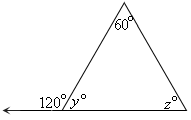Solved Examples and Worksheet for Angle Sum Theorem and Medians in a Triangle
A. 58o, 81o, 77o
B. 38o, 55o, 72o
C. 48o, 60o, 72o
D. 96o, 60o, 97o
Step: 1
Let 4x x x
Step: 2
4x x x
[Triangle angle sum theorem.]
Step: 3
15x
x 1 8 0 ° 1 5
x
[Divide each side by 15.]
Step: 4
So, 4x
5x
6x
5
6
[Substitute x
Step: 5
The angles of the triangle are 48o, 60o and 72o .
Correct Answer is : 48o, 60o, 72o
(i) One arm of
(ii).
(iii). m
(iv) m
(v).
A. (i), (ii) and (v)
B. (ii), (iii), (iv) and (v)
C. All statements
D. (ii), (iii) and (iv)
Step: 1
The two angles can be with two different arms. Statement (i) need not be correct.
Step: 2
The two angles can be the angles of the same triangle since sum of the angles of a triangle is 180 degrees.
Step: 3
(ii), (iii) and (iv) are correct.
Correct Answer is : (ii), (iii) and (iv)
Step: 1
[Linear pair.]
Step: 2
[Simplify.]
Step: 3
The sum of the measures of the angles of a triangle is 180.
[Triangle angle sum theorem.]
Step: 4
60 + y z
[From step 3.]
Step: 5
60 + 60 + z
[Substitute 60 for y
Step: 6
[Simplify.]
Step: 7
So, 2y z
[Substitute 60 for y z
Correct Answer is : 300
Step: 1
The measure of each exterior angle of a triangle equals the sum of the measures of its two remote interior angles.
[Exterior angle theorem.]
Step: 2
[From step 1.]
Step: 3
The sum of the measure of the angles of a triangle is 180.
[Triangle angle-sum theorem.]
Step: 4
[From step 3.]
Step: 5
[Substitute y x
Step: 6
5x ⇒ x
[Simplify.]
Step: 7
[From step 2.]
Step: 8
Hence the value of x y
Correct Answer is : 36 and 72
A. 90°
B. 120°
C. 60°
D. 100°
Step: 1
Since the measures of the angles of the triangle are in the ratio 2: 4: 6, the measures of the angles of triangle can be taken as 2x x x
Step: 2
The sum of the measure of angles of a triangle is 180.
[Triangle angle sum theorem.]
Step: 3
2x x x
[ From steps 1 and 2 ]
Step: 4
12x
[Simplify]
Step: 5
[solve for x
Step: 6
The measures of the angles of triangle are,
Step: 7
2x
Step: 8
4x
Step: 9
6x
Step: 10
Therefore, the largest angle of a triangle = 90°.
Correct Answer is : 90°
A. 84°
B. 6°
C. 36°
D. 48°
Step: 1
The sum of all the three angles in a triangle is 180°.
[Angle sum theorem of a triangle.]
Step: 2
The measures of angles of a triangle are perfect squares.
[Given.]
Step: 3
If the angles of a triangle are a b c a b c a b c
Step: 4
Let the angles be a b c
Step: 5
⇒ 16 + 64 + 100 = 180
[16 = 42, 64 = 82, and 100 = 102.]
Step: 6
Here, the largest angle is 100 and the smallest angle is 16.
Step: 7
So, the difference between the largest and the smallest angles = 100 - 16 = 84°.
Correct Answer is : 84°

A. 28°
B. 45°
C. 36°
D. cannot be determined
Step: 1
The sum of all the angle measures of a triangle is 180°.
Step: 2
90° + 62° + y
[Equate the sum of angles of the triangle to 180°.]
Step: 3
152° + y
[Add.]
Step: 4
[Subtract 152° from each side.]
Correct Answer is : 28°
A. 100°, 60°, 95°
B. 40°, 55°, 70°
C. 60°, 81°, 75°
D. 50°, 60°, 70°
Step: 1
Let 5x x x
Step: 2
Sum of the measures of the angles in a triangle = 180°
Step: 3
5x x x
18x
x 1 8 0 ° 1 8
x
18
[Divide each side by 18.]
Step: 4
5x
6x
7x
6
7
[Substitute x
Step: 5
The measures of the angles are 50°, 60° and 70° .
Correct Answer is : 50°, 60°, 70°
A. The three medians of a triangle are always concurrent inside of it.
B. A median of a triangle is a line segment joining a vertex to the midpoint of the opposite side.
C. The point of concurrency of the three medians of a triangle is called the centroid.
D. The length of the median from the centroid to the opposite side of the vertex is equal to the length of the median from the vertex to the centroid.
Step: 1
The centroid of a triangle divides the medians in the ratio 2:1. That is A G G D
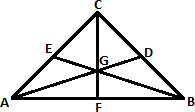

Step: 2
Step: 3
Therefore, the length of the median from the centroid to the opposite side of the vertex is equal to half the length of the median from the vertex to the centroid.
Correct Answer is : The length of the median from the centroid to the opposite side of the vertex is equal to the length of the median from the vertex to the centroid.
A. 3 : 1
B. 2 : 1
C. 3 : 2
D. 1 : 2
Step: 1

Step: 2
The centroid of a triangle divides the medians in the ratio 2:1.
Step: 3
That is AG : GD = 2 : 1.
Step: 4
Step: 5
AD = AG + GD = 2 GD + GD = 3 GD.
Step: 6
⇒ A D G D 3 1
Step: 7
Therefore,AD : GD = 3 : 1.
Correct Answer is : 3 : 1
A. No median coincides with an altitude in an isosceles triangle.
B. At least one median coincides with an altitude in both isosceles and equilateral triangles.
C. No median coincides with an altitude in an equilateral triangle.
D. No median coincides with an altitude either in an isosceles triangle or in an equilateral triangle.
Step: 1
In an equilateral triangle, the median from any vertex to the opposite side will be perpendicular to that side.
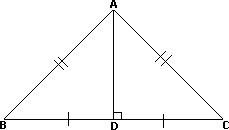

Step: 2
In an isosceles triangle, the median from the vertex containing the congruent sides is perpendicular to the base.
Step: 3
So, in both isosceles triangle and equilateral triangle, at least one median coincides with an altitude.
Correct Answer is : At least one median coincides with an altitude in both isosceles and equilateral triangles.
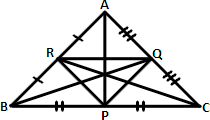
A. 16 cm, 20 cm and 24 cm respectively
B. 4 cm, 5 cm and 6 cm respectively
C. 12 cm, 15 cm and 18 cm respectively
D. 8 cm, 10 cm and 12 cm respectively
Step: 1
PQ || AB, QR || BC, PR ||AC
[Mid-segment theorem.]
Step: 2
PQ = 1 2
Step: 3
QR = 1 2
Step: 4
PR = 1 2
Correct Answer is : 16 cm, 20 cm and 24 cm respectively
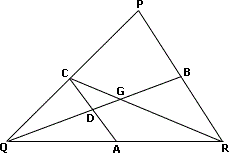
A. 5 cm
B. 8 cm
C. 10 cm
D. 15 cm
Step: 1
ΔPQR ~ ΔCQA
[A and C are midpoints of QR and PQ and AC is the midsegment.]
Step: 2
⇒ Q D Q B 1 2 Q D Q D + D B 1 2
[Ratio of the sides of the similar triangles ΔCQA and ΔPQR is 1 : 2.]
Step: 3
2QD = QD + DB ⇒ QD = DB = 15 cm
[DB = BD = 15 cm.]
Step: 4
QB = QD + DB = 15 cm + 15 cm = 30 cm
Step: 5
QG = 2 3 2 3
[G is the point of intersection of the medians, which divides the median in 2 : 1 ratio.]
Step: 6
GD = QG - QD = 20 - 15 = 5 cm
Correct Answer is : 5 cm
- Points, Rays, Angles, Lines and Line Segments-Geometry-Solved Examples
- Parallel Lines and Transversals-Geometry-Solved Examples
- Properties of Isosceles Triangles-Geometry-Solved Examples
- Proving Quadrilateral is a Parallelogram-Geometry-Solved Examples
- ASA and AAS Postulates -Triangle Congruence-Geometry-Solved Examples
- SSS and SAS Postulates-Triangle Congruence-Geometry-Solved Examples
- Transformations-Reflections-Geometry-Solved Examples
- Transformations-Rotations-Geometry-Solved Examples
- Transformations-Translations-Geometry-Solved Examples
